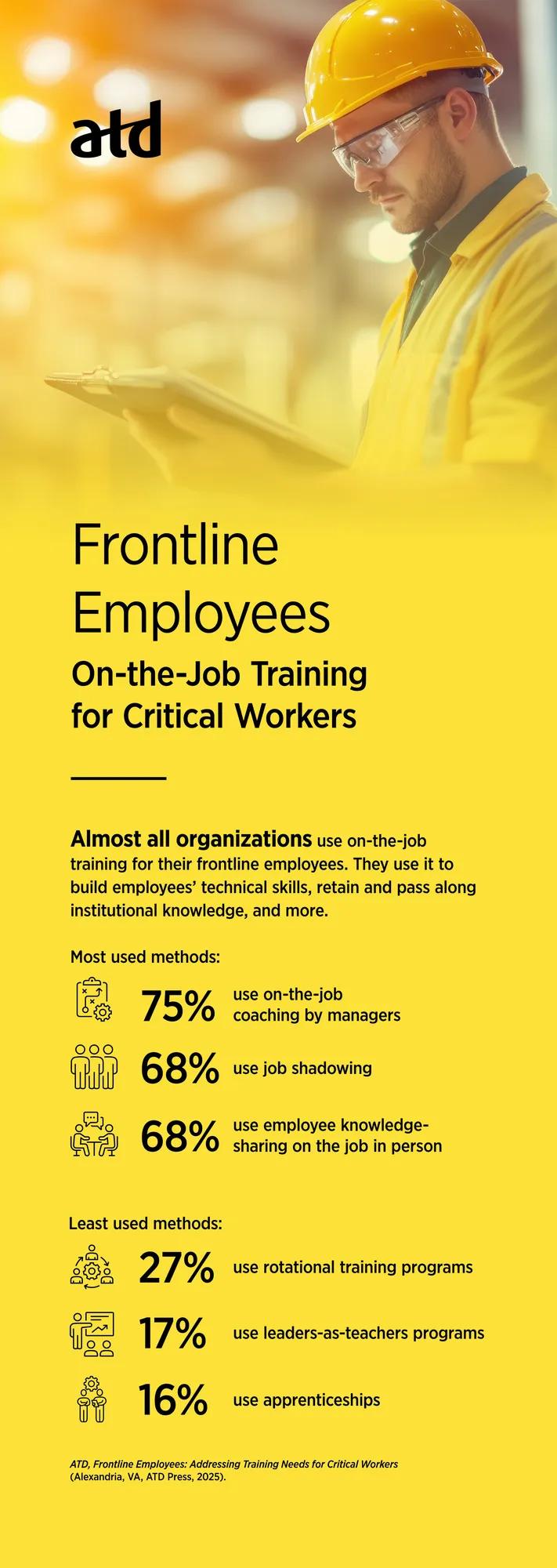ATD Blog
On-the-Job Training for Frontline Employees
New ATD Research study finds that 95 percent of organizations use on-the-job training to build frontline employees’ technical and hard skills.
Wed Feb 19 2025

Bookmark
Comfortable. Confident. Capable. JD Dillon, chief learning architect at Axonify, calls these the “three C’s.” They describe the characteristics required for frontline employees to effectively do their work. Frontline employees are professionals who do not regularly work at a desk or computer—for example, retail clerks, utilities technicians, hospitality staff, warehouse associates, and nurses. They typically work in shifts, move throughout the workday, and may even travel to several locations in one day.
In January 2025, ATD Research published Frontline Employees: Addressing Training Needs for Critical Workers, sponsored by Axonify. The study surveyed 334 talent development (TD) professionals to understand how their organizations deliver training to frontline employees. We found that in addition to formal learning, almost all organizations use on-the-job training (OJT) with their frontline employees.
OJT is a type of informal learning that allows employees to develop skills in the actual job environment. Our study found that 95 percent of organizations use it to build employees’ technical and hard skills, which are critical to frontline work. OJT is also commonly used to retain and pass along institutional knowledge as well as familiarize employees with the industry their organization operates in.
There are a variety of ways organizations can offer OJT to frontline employees. Our study found that on-the-job coaching by managers is the most common method of OJT, used by three-quarters of organizations. TD professionals cited job shadowing and employee knowledge sharing as the two next most common methods of OJT, with 68 percent using each, respectively.
Less commonly used methods of OJT include rotational training programs, leaders-as-teachers programs, and apprenticeships. However, these methods can provide a variety of benefits to organizations and their frontline employees. For instance, according to CO by the U.S. Chamber of Commerce, rotational training programs can help employees figure out what kind of work they enjoy and increase employee engagement. Additionally, rotational training programs cross-train multiple employees to do the same job; so, if one employee leaves their job, another employee is ready to fill that position. According to Indeed, while apprenticeships are mostly used for skilled trades in the United States, the apprenticeship model can be used for a variety of roles to promote practice and nurture skills growth. Apprenticeships provide one-on-one support in a hands-on training experience, giving employees the opportunity to, in real time, apply their knowledge and skills as well as receive immediate feedback.
To learn more about how organizations are using OJT for frontline employees, as well as other kinds of training such as formal and AI-enabled training, check out Frontline Employees: Addressing Training Needs for Critical Workers. Whether your organization is just starting to offer training to frontline employees, or it has already established robust learning programs, you can use this report to benchmark and help plan your next steps in ensuring your critical workers are empowered with the right tools to succeed.

More from ATD

